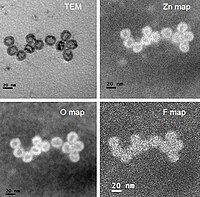
Photo from wikipedia
Abstract In this study, we analyzed the effect of the composition and thickness of shell material on morphology, structure and optical properties of ultrathin CdSe/CdS, CdSe/CdS/ZnS and CdSe/ZnS core-shell nanoplatelets.… Click to show full abstract
Abstract In this study, we analyzed the effect of the composition and thickness of shell material on morphology, structure and optical properties of ultrathin CdSe/CdS, CdSe/CdS/ZnS and CdSe/ZnS core-shell nanoplatelets. It is shown that the growth of CdS and ZnS shells on ultrathin CdSe nanoplatelets with excitonic absorption at 463 nm leads to the formation of flat CdSe/CdS and CdSe/CdS/ZnS and folded CdSe/ZnS core-shell heterostructures, respectively. The tuning of the first excitonic transition in a range of 510–635 nm is shown by changing the composition and thickness of the shell material. Despite large lateral sizes, the CdSe/CdS and CdSe/CdS/ZnS core-shell nanoplatelets showed narrow emission bands with about 18–21 nm width. Emission width of the CdSe/ZnS heterostructures is shown to be thickness dependent and broader than that of CdSe/CdS and CdSe/CdS/ZnS heterostructures. Such control of the electronic structure of 2D core-shell nanoparticles, simply by changing the thickness and composition of the shell material may be attractive for the light-emitting device technology and lasers.
Journal Title: Journal of Luminescence
Year Published: 2019
Link to full text (if available)
Share on Social Media: Sign Up to like & get
recommendations!